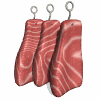
These 2 animations (Audio - Important) describe the sliding filament model of muscle contraction.
version 1.
version 2.
Attachments
A skeletal muscle originates at a point of attachment to a stationary bone. The insertion of a muscle is the portion attached to the bone that moves during contraction.
An extensor extends or straightens the bones at a joint as in straightening out a limb. A flexor bends a joint to an acute angle, as in bending the elbow to bring the forearm and upper arm together.
This animation (Audio - Important) describes muscle movement.
Types of Muscles
Vertebrates possess three different types of muscle tissues defined by their appearance, location, and function:
Smooth muscle , or involuntary muscle, is generally found in visceral systems (internal organs) and is innervated by the autonomic nervous system. Each muscle fiber consists of a single cell with one centrally located nucleus. Smooth muscle is nonstriated. Examples are the muscles found in the walls of the arteries and veins, the walls of the digestive tract, the bladder, and the uterus.
Skeletal muscle tissue attaches to bones for voluntary movement . Skeletal muscles, or voluntary muscles, produce intentional physical movement. Each fiber is multinucleated (that is, it has more than one nucleus in each cell) and is crossed by alternating light and dark bands called striations. The striations are caused by overlapping strands of the contractile proteins actin and myosin. Skeletal muscles also have sarcomeres, or contractile units. The somatic nervous system innervates skeletal muscle.
This animation (Audio - Important) describes the structure of skeletal muscle.
This animation (Audio - Important) describes the structure of a sarcomere.
Cardiac (heart) muscle is composed of short, striated cells that can function in units. Cardiac muscle is the tissue that makes up the heart. It has characteristics of both skeletal and smooth muscle. This means it is both striated and mononucleate. It is regulated by the autonomic nervous system, increasing the rate and strength with sympathetic stimulation and decreased in rate by the parasympathetic system. The nervous system modulates the inherent heart beat of cardiac muscle.
Take a look at the Molecular Mechanism of Muscle Contraction Tutorial.
REVIEW: Smooth muscle is�?
REVIEW: Which of the following includes all the others?
REVIEW: The sliding filament theory states that, during muscle contraction and relaxation,��
REVIEW: During muscle contraction, calcium ions bind to��
REVIEW: �After a myosin head has performed a power stroke, it must first bind to _____ in order
to perform another power stroke.�
a. actin
b. myofibril
c. myosin
d. myofilament
e. muscle cell�
PREVIOUS
NEXT
LECTURE 21 INDEX
MAIN INDEX